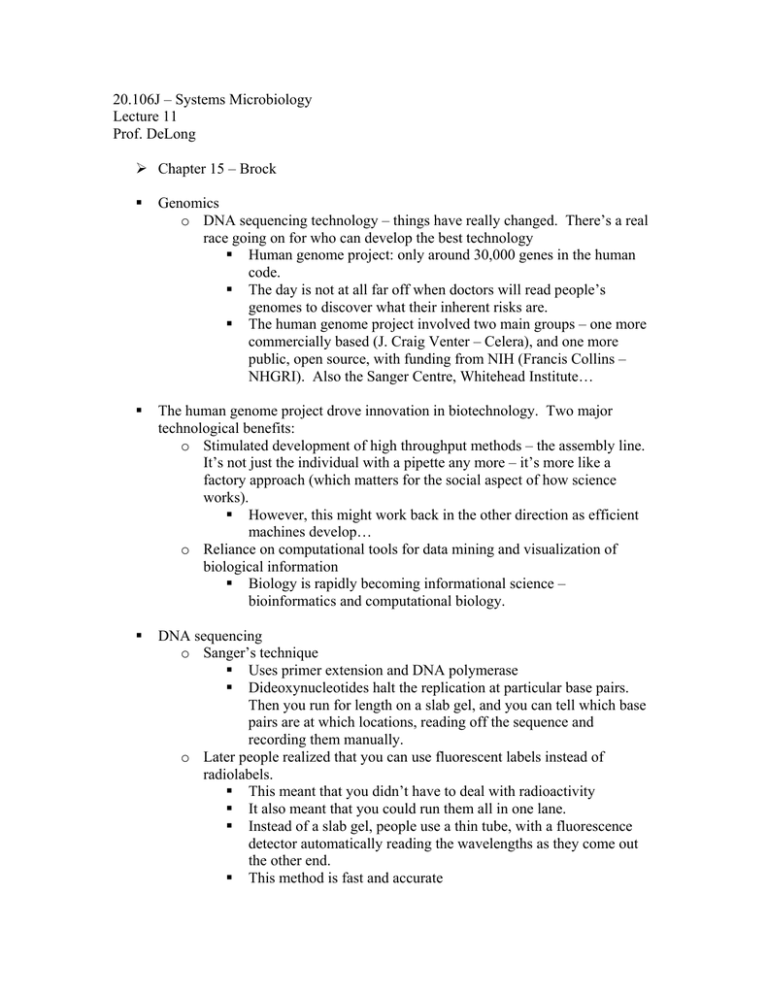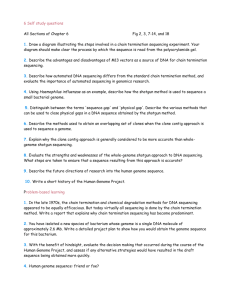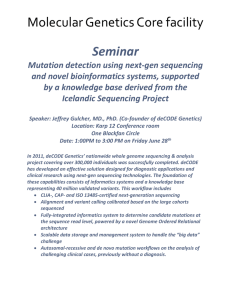20.106J – Systems Microbiology Lecture 11 Prof. DeLong
advertisement

20.106J – Systems Microbiology Lecture 11 Prof. DeLong ¾ Chapter 15 – Brock Genomics o DNA sequencing technology – things have really changed. There’s a real race going on for who can develop the best technology Human genome project: only around 30,000 genes in the human code. The day is not at all far off when doctors will read people’s genomes to discover what their inherent risks are. The human genome project involved two main groups – one more commercially based (J. Craig Venter – Celera), and one more public, open source, with funding from NIH (Francis Collins – NHGRI). Also the Sanger Centre, Whitehead Institute… The human genome project drove innovation in biotechnology. Two major technological benefits: o Stimulated development of high throughput methods – the assembly line. It’s not just the individual with a pipette any more – it’s more like a factory approach (which matters for the social aspect of how science works). However, this might work back in the other direction as efficient machines develop… o Reliance on computational tools for data mining and visualization of biological information Biology is rapidly becoming informational science – bioinformatics and computational biology. DNA sequencing o Sanger’s technique Uses primer extension and DNA polymerase Dideoxynucleotides halt the replication at particular base pairs. Then you run for length on a slab gel, and you can tell which base pairs are at which locations, reading off the sequence and recording them manually. o Later people realized that you can use fluorescent labels instead of radiolabels. This meant that you didn’t have to deal with radioactivity It also meant that you could run them all in one lane. Instead of a slab gel, people use a thin tube, with a fluorescence detector automatically reading the wavelengths as they come out the other end. This method is fast and accurate o Graph: the progress of the Human Genome Project o Shotgun genome sequencing – what about the gaps? Doing a complete sequence for a bacterial genome is still expensive – around 10 or 20 thousand dollars, but it’s relatively straightforward. o Small insert cloning/sequencing o There are automated plate pickers now o Some people thought that shotgun sequencing would work (the Celera group used this) but others thought that it wouldn’t (the public consortium used a different method) o BAC sequencing – larger segments, you know where they lie on the genome o Both approaches have advantages: shotgun sequencing is much quicker, but BAC sequencing closes the gaps – the best method is to use some of both. o 454 Sequencing – Commercial, massively parallel DNA sequencing technology: Run PCR with beads, each of which attaches to on strand of DNA Emulsion PCR Lots of DNA comes from an individual strand. You pour the reaction over a chip with tiny wells that each fit one bead. 1.5 million reactions all at once Thus the factory approach to sequencing is no longer necessary – it can all be done in little machines like this. It’s still pretty expensive, but it’s getting closer, and it’s changing things rapidly. o The evolution of sequencing is moving towards nano-methods, and pretty soon there will probably be sequencing technologies in hospitals. Microbial genomes o The first complete, published microbial genome came in 1995. o Incomplete bacterial genomes in process is now approaching 2,500. o Archeal genomes have been studied less. o Most of the DNA sequencing is happening at select sequencing centers, and it will probably continue to consolidate in this way. o Archeal genomes are generally smaller. o The smaller genomes are typically associated with obligate parasites. There are obligate symbionts in some insects that live inside the cell and just work as little amino acid factories. • Called Carsonella • They have extremely small genomes • It’s also very very AT rich (very little GC content) • The genome basically only has replication mechanisms and the DNA for amino acid synthesis • These symbionts are on their way toward becoming essentially organelles o We’re figuring out what sort of genes scale with genome size.






